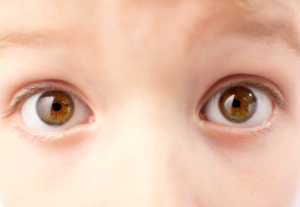Did you know that conjunctivitis, often called “pink eye,” is one of the most common eye conditions in the United States. It can be highly contagious and easily spread in schools and at home.
Conjunctivitis is an inflammation of the conjunctiva, which is the clear membrane that lines the inside of the eyelids and continues over the white of the eyeball. The condition may vary from mild redness with a watery eye to a severe infection that can affect your child’s vision.
What causes conjunctivitis?
Conjunctivitis occurs when the conjunctiva is irritated, or infected by a virus or bacteria. In some cases, a red eye can be caused by allergic reactions or by chemicals and irritants in the air, such as smoke and pollen or chlorine and other chemicals in swimming pools.
Types of Conjunctivitis:
- Allergic Conjunctivitis
This type of conjunctivitis is mostly caused by an allergic reaction, is not an infection, and is not contagious. It often occurs in children with a history of other allergies. Signs may include itchy or a runny nose and sneezing with eyes being itchy and watery. A child who has allergic conjunctivitis frequently rubs their eyes.
- Infectious Conjunctivitis
This type of conjunctivitis is caused by a viral or bacterial infection, which may be highly contagious. Your child can get conjunctivitis from contact with a person who is infected or through something an infected person has touched. During the summertime, it can spread when children swim in contaminated water or share contaminated towels. Your child may continue spreading the infection as long as the eye discharge is present.
If your child has this type of infection, do not allow them to share eye drops, tissues, towels or pillowcases with other people. They should be kept away from school until the discharge from the eye has cleared. Make sure your child washes their hands regularly and thoroughly to prevent the infection from spreading to others.
Warning Signs and Symptoms:
The most common signs of conjunctivitis are red, irritated eyes; excessive tearing; and itching. Your child may also wake up with their eyelashes stuck together due to dried mucus forming during the night. The condition can affect one or both eyes and can cause a ‘gritty’ feeling. Although vision is unaffected, your child’s eyes may be sensitive to light. There is usually a stickiness of the eyelids present. In some of the worst cases, the eyelids are swollen.
This eye infection can be confused with more serious eye conditions such as Iritis. This is the reason why it is very important to have your child’s eye condition diagnosed and treated by a qualified pediatric ophthalmologist.
Conjunctivitis Treatment:
It is best to have your child examined by an eye doctor or pediatrician to determine the cause and take appropriate treatment.
Your child’s eye doctor may advise you to clean the eyelids with a moist towel to clean the discharge. This should be done every few hours to make your child feel better. Antibiotic eye drops, ointments, or other eye medications may also be prescribed if your child has allergic conjunctivitis.
Letting your child wear tinted glasses is also a great way to relieve discomfort from bright light. It can serve as a cosmetic shield for the reddened and swollen eyes. Making use of an eye patch is not advisable as this can make the infection worse.
Conjunctivitis Prevention:
As mentioned above, conjunctivitis can be highly contagious, so teach your child to wash their hands with warm water and soap as often as possible.
Always make sure to wash your hands thoroughly as well, especially after touching your child’s infected eyes. Immediately throw away items used on the area, such as tissues or cotton balls. Wash towels and other linens used by your child SEPARATELY and in hot water to avoid contamination.
If you think your child was infected with conjunctivitis, do not hesitate to contact our children’s ophthalmologist in Livingston! Call directly at 973-422-1230 or email us at: [email protected]
The material contained on this site is for informational purposes only and DOES NOT CONSTITUTE THE PROVIDING OF MEDICAL ADVICE, and is not intended to be a substitute for independent professional medical judgment, advice, diagnosis, or treatment. Always seek the advice of your physician or other qualified healthcare provider with any questions or concerns you may have regarding your health.
